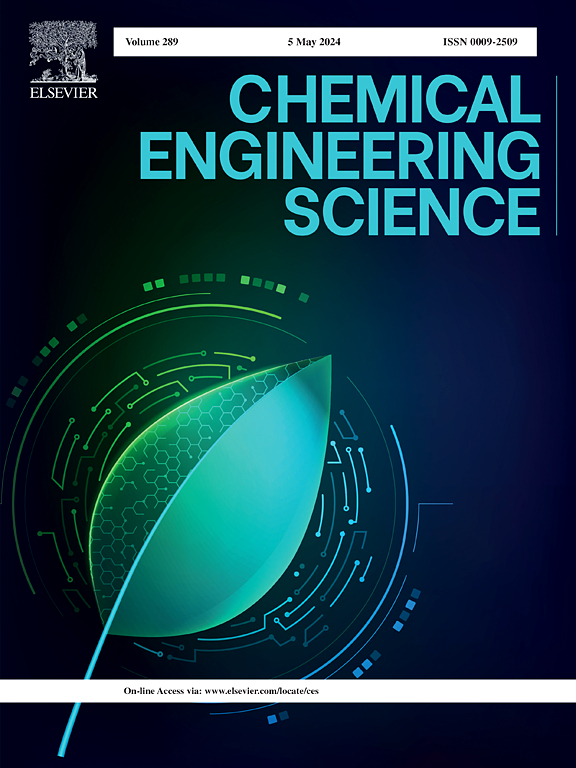Numerical simulation of homogeneous elemental mercury oxidation within an electrostatic precipitator
IF 4.1
2区 工程技术
Q2 ENGINEERING, CHEMICAL
引用次数: 0
Abstract
The corona discharge in electrostatic precipitator (ESP) can contribute to homogenous Hg0 oxidation, thus favoring the simultaneous removal of mercury by the existing air pollution control devices in coal-fired power plant. A multi-field model consisting of reaction kinetics and dynamics was established to simulate the Hg0 oxidation performance in ESPs. The HCl dissociation products (i.e., Cl and Cl2) were responsible for the oxidation of Hg0 to HgCl2 and HgCl, in which the Hg0 oxidation efficiency (EHg) was increased from 13.3 % to 52.6 % with the increase of HCl concentration from 1 to 4 ppm. The increase of O2 concentration from 2 % to 8 % resulted in 2.1 % reduction of EHg, which was primary attributed to the inhibition of HCl dissociation process to form Cl-containing species. As the H2O content increased from 3 % to 12 %, EHg rose from 25.9 % to 29.1 %, due to H2O dissociation products (i.e., H and OH) enhancing the formation of Cl-containing species from HCl dissociation. The voltage fluctuations demonstrated dual effects on EHg: increasing from 35 kV to 40 kV reduced efficiency from 27.3 % to 26.4 %, attributed to diminished Cl-containing species, whereas further increasing to 50 kV enhanced efficiency to 32.1 % due to increased production of O-containing substances. A higher flow rate facilitated the escape of reactive chemical species from ESPs. The EHg decreased from 36.3 % to 17.5 % when the flow velocity increased from 0.1 to 0.25 m/s. These results clarified the key factors for affecting Hg0 oxidation within an ESP, which provides the fundamental to simultaneously control Hg0 emission from coal-fired power plants.

静电除尘器内均质元素汞氧化的数值模拟
静电除尘器(ESP)中的电晕放电可促进均匀的 Hg0 氧化,从而有利于现有燃煤电厂大气污染控制装置同时去除汞。建立了一个由反应动力学和动力学组成的多场模型来模拟静电除尘器的 Hg0 氧化性能。HCl 的解离产物(即 Cl 和 Cl2)将 Hg0 氧化成 HgCl2 和 HgCl,其中 Hg0 氧化效率(EHg)随 HCl 浓度从 1 ppm 增加到 4 ppm 而从 13.3 % 增加到 52.6 %。氧气浓度从 2% 增加到 8% 时,EHg 下降了 2.1%,这主要是由于 HCl 解离过程中形成含 Cl 物种的过程受到了抑制。随着 H2O 含量从 3% 增加到 12%,EHg 从 25.9% 上升到 29.1%,这是由于 H2O 解离产物(即 H 和 OH)增强了 HCl 解离形成的含 Cl 物种。电压波动对 EHg 有双重影响:电压从 35 千伏升至 40 千伏,效率从 27.3% 降至 26.4%,原因是含 Cl 物种减少;而电压进一步升至 50 千伏,效率升至 32.1%,原因是含 O 物种增多。更高的流速有利于活性化学物质从静电除尘装置中逸出。当流速从 0.1 米/秒增加到 0.25 米/秒时,EHg 从 36.3% 下降到 17.5%。这些结果阐明了影响静电除尘器内氧化 Hg0 的关键因素,为同时控制燃煤电厂的 Hg0 排放提供了基础。
本文章由计算机程序翻译,如有差异,请以英文原文为准。
求助全文
约1分钟内获得全文
求助全文
来源期刊

Chemical Engineering Science
工程技术-工程:化工
CiteScore
7.50
自引率
8.50%
发文量
1025
审稿时长
50 days
期刊介绍:
Chemical engineering enables the transformation of natural resources and energy into useful products for society. It draws on and applies natural sciences, mathematics and economics, and has developed fundamental engineering science that underpins the discipline.
Chemical Engineering Science (CES) has been publishing papers on the fundamentals of chemical engineering since 1951. CES is the platform where the most significant advances in the discipline have ever since been published. Chemical Engineering Science has accompanied and sustained chemical engineering through its development into the vibrant and broad scientific discipline it is today.
 求助内容:
求助内容: 应助结果提醒方式:
应助结果提醒方式:


